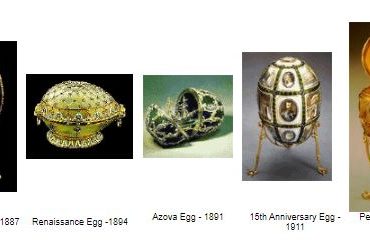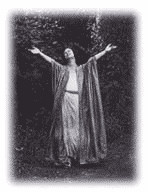Darrelyn Gunzburg
March 2007
Prince William (21 June 1982, 21:03 London, England), the young man whose shy sideways glance seals forever the immortality of his mother, Diana, Princess of Wales, in his face, was born on an eclipse (Sun and Moon conjunct the North Node) – (Saros Series 2 Old North or van den Bergh 117)
When someone is born on an eclipse, the essence of that eclipse is contained as part of the person’s fate or pathway. Brady [1] describes Saros Series 2 Old North as being “a difficult eclipse family” in terms of friendships or relationships where the person has to face the results of separation or endings in some way. This Saros Series, however, also contains a note of optimism, for if the situation is handled with timely action, such action can turn disaster into triumph and that:
…lives touched by this Series often symbolize schism rift or disunion. Life’s challenges will highlight the ability to act quickly, allowing old structures to crumble while learning how to create new forms from the collapse of the old ones.[2]
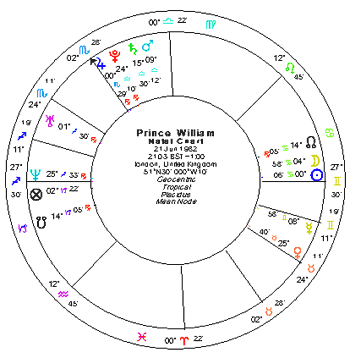
William’s history is not new to us. He was born as the obligatory first son, heir to the heir of the throne, when Diana’s and Charles’ relationship was already under siege. The changes made since Diana’s death to the Royals’ personal relationships – Charles’ marriage to Camilla, and William’s and Harry’s intimate relationships with “commoners” – are the legacy of her demise. Yet William embodied this Saros Series in an action so far removed from that of his mother and father when he and his current girlfriend, Kate Middleton, lived together as students whilst studying at St. Andrews University until their graduation in 2005. Although he says he does not wish to marry before the age of twenty-eight, if William marries Kate Middleton, it will be the first time in history that a future king has married a commoner who is not an aristocrat.
Perhaps one meaning for William being born on this eclipse is the “separation and ending” of the tradition of a monarch marrying (or being) a virgin and of royal blood.
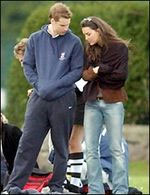
Another meaning is that William may, in some way, change the role of the monarchy, a view long held by astrologers. The Saros Series commenced in 792, almost the time of the beginning of the Royal Monarchy, and completes in July 2036 when William will be fifty-four years old. David Starkey [3] writes that the English monarchy, now over fifteen hundred years old.
“… is the oldest functioning political institution in Europe. It is also unique because, right from the beginning, the English monarchy had a strong popular element. This means that its history is more than a tale of kings and queens, or royal heroes like King Alfred and Henry V and crowned villains like King John. It’s also the story of a dialogue between king and people in which the English people learned to rule themselves…”
Brady’s[4] suggested writing in 1992 that:
“…for Prince William, a future King of England, to be part of this Series is to presuppose that he may well be the last British Monarch in the current style… He would then find himself face with the choice of either adapting very quickly or being swept away with the old structure.”
We can gain further insight into this eclipse and the role it plays in William’s life by considering the fixed stars that sit underneath this Sun and Moon. These are Deneb Algedi with the Sun and the Moon and Facies with the Moon, all of which come into play in William’s life in his culminating years, the years of his prime, we could say those years after his Saturn return and when he is most likely to sit upon the throne.
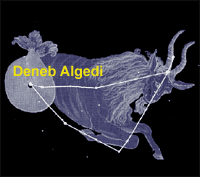
Deneb Algedi sits in the tail of Capricorn, the sea-goat, carrying the concept of the law-giving, justice orientated, civilizing saviour, the benefic ruler using wisdom and knowledge to protect and help his people William’s Sun is in the 7th house, so he needs to be in relationship (either intimate and/or, as future heir to the throne, with the people of Britain). He learns this from both his parents (Sun-Moon in the 7th house) and with his Sun being in opposition to Neptune across the Ascendant-Descendant axis [5], this relationship in its best expression is one of gentleness, connected with the arts, religion, the sea, travel or metaphysics and defined by clear boundaries and high principals. William’s University degree was in art history (Sun-Neptune), an early expression of this aspect. We can add to our understanding of what type of ruler he will be by considering his luminaries both in paran with Deneb Algedi, as defined in Starlight:
Deneb Algedi as the Sun is Rising –
To be respected, to give wisdom
Deneb Algedi as the Moon is Rising
A story-teller, the use of story to promote greater awareness of humanity
We could say that on the throne William brings a gentle, yin approach (Sun-Moon in Cancer, Sun opposition Neptune) to his role as monarch, always being confronted with issues of integrity (Sun-Neptune) in order to protect and help his people (in paran with Deneb Algedi) and thus gaining respect (Sun in paran with Deneb Algedi). In some way he also utilises his training in art history “the use of story to promote greater awareness of humanity” (Moon in paran with Deneb Algedi). When we connect this with William being born under an eclipse, it would appear from his fixed stars that he is able to change the monarch’s role in a way that is respected by the people.
Yet William also has Facies in paran with his Moon. Once again from Starlight we have
Facies as the Moon is On Nadir
Emotionally experiencing violence or turmoil
I have considered Facies in other Visual Astrology Newsletters: when Facies makes a paran to a planet or luminary in a person’s chart, if it is the only difficult star, the planet it touches will be extremely focused and driven. In William’s chart, given that he is the one who changes the monarch’s role in society, such a fixed star sitting underneath his Moon makes sense, particularly when linked with Deneb Algedi in the same time period. Here is someone who is respected (Moon in paran with Deneb Algedi) for their ability to publicly change, yet who experiences emotional turmoil (Moon in paran with Facies) in so doing.
Time will tell as events unfold just how this will manifest for Prince William and the English Royal family but we can see from the above how the marriage of understanding what it means to be born on an eclipse along with the meanings of the fixed star in paran with the person’s Sun and Moon gives a depth and poignancy to a person’s pathway.
[1] Brady, Bernadette. (1992,1999) Predictive Astrology: The Eagle and The Lark, York Beach: Samuel Weiser Inc. p.309.
[2] op.cit, p.236.
[3] Starkey, David. (2004) The Monarchy of England: Volume I – The Beginnings, London: Chatto and Windus.
[4] Brady, p.236.
[5] William’s Sun is only 6 minutes into the sign of Cancer, therefore I consider it making an opposition to Neptune.



